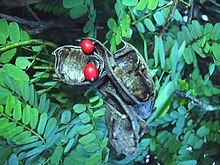Jequirity
| Abrus precatorius | |
|---|---|
 |
|
| Scientific classification | |
| Kingdom: | Plantae |
| (unranked): | Angiosperms |
| (unranked): | Eudicots |
| (unranked): | Rosids |
| Order: | Fabales |
| Family: | Fabaceae |
| Genus: | Abrus |
| Species: | A. precatorius |
| Binomial name | |
|
Abrus precatorius L., 1753 |
|
Abrus precatorius, known commonly as jequirity, Crab's eye, or crab's eye creeper, cock's eyes, rosary pea, paternoster pea, love pea, precatory pea or bean, prayer bead, John Crow Bead, coral bead, red-bead vine, country licorice, Indian licorice, wild licorice, Jamaica wild licorice, Akar Saga, coondrimany, gidee gidee,Jumbie bead ratti/rettee/retty, or weather plant, is a slender, perennial climber that twines around trees, shrubs, and hedges. It is a legume with long, pinnate-leafleted leaves.
The plant is best known for its seeds, which are used as beads and in percussion instruments, and which are toxic because of the presence of abrin. Ingestion of a single seed, well chewed, can be fatal to both adults and children. The plant is native to India and grows in tropical and subtropical areas of the world where it has been introduced. It has a tendency to become weedy and invasive where it has been introduced.
Abrus precatorius is a severely invasive plant in warm temperate to tropical regions, so much so that it has become effectively pantropical in distribution. It had been widely introduced by humans, and the brightly coloured and hard-shelled seeds had been spread by birds. By the end of the twentieth century, it had been proclaimed as an invasive weed in many regions including some in Belize, Caribbean Islands, Hawaii, Polynesia and parts of the mainland United States. In Florida in particular, the plant has invaded undisturbed pinelands and hammocks, including the vulnerable pine rocklands.
Once Abrus precatorius plants have grown to maturity under favourable conditions, their deep roots are extremely difficult to remove, and the plants' aggressive growth, hard-shelled seeds, and ability to sucker, renders an infestation extremely difficult to eradicate and makes it very difficult to prevent re-infestation. Herbicides such as glyphosate are effective, but need skilled application if they are not to do more harm than good.
The toxin abrin is a dimer consisting of two protein subunits, termed A and B. The B chain facilitates abrin's entry into a cell by bonding to certain transport proteins on cell membranes, which then transport the toxin into the cell. Once inside the cell, the A chain prevents protein synthesis by inactivating the 26S subunit of the ribosome. One molecule of abrin will inactivate up to 1,500 ribosomes per second.
...
Wikipedia
